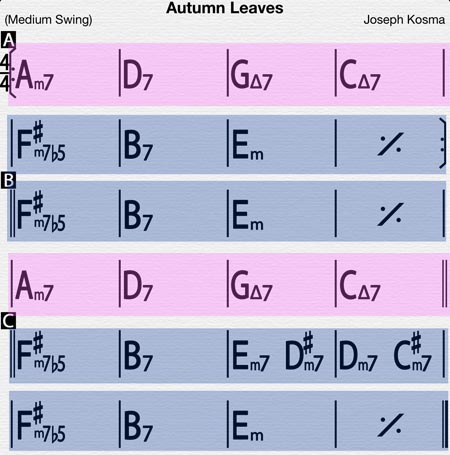« Best of JM: Raking it in. Autumn Leaves Pt. 1 |
Main
| Reverse Dorian/Minor Arpeggios »
 July 31, 2014 | Best of JM: Raking it in. Autumn Leaves Pt. 2 July 31, 2014 | Best of JM: Raking it in. Autumn Leaves Pt. 2
Enjoy the popular archive material below.
From July 12, 2012 | Raking it in. Autumn Leaves Pt. 2.
We last looked at the jazz classic "Autumn Leaves" Part 1 for the opportunity to take two simple one-octave scale patterns up the neck (E dorian/minor and G major) to begin to craft effective improvisation.
 
Hopefully, you took the time to work the FFcP patterns for these into your fingers, and feel some degree of comfort playing out of open position. It's great if you have some backing tracks (or an accompanying instrumentalist) to start to break out of the patterns and experiment with some soloing. This is where the rubber meets the road with the FFcP exercises. Out of the lab and into the field...
Scales vs. Licks
We've talked about two distinct approaches to improvisation, one using the framework of scales, the other using licks or motives from other songs and moving them around the fretboard. There's a viable school of thought that spending time transcribing and analyzing other artists' work to get into their heads for these sound nuggets, and begin the process of recreating your own licks. We think both approaches are necessary in optimal creativity. The scale approach can give you efficient, map like access to the "right" notes, but at the risk of sounding sterile or clinical. The "lick" approach gives great material, too, but leaves you dependent on others for material, and can leave you stuck endlessly repeating the same material.
We've worked up something that's a little of both, and cover it in the book "Getting Into Jazz Mandolin." For example, the "ii V7 I" patterns roll out the classic cadence and offer increasingly complex licks based on the scale. Pardon the hard sell, but this is a compelling reason alone to acquire the book, since it covers all four FFcP patterns in both major and minor keys. For now, we'll give you a taste, and you can even apply this material to "Autumn Leaves."
Take a moment to play through these, and see how they might be your own personal starting point to jamming with this terrific tune.
Download two page PDF:  E Minor ii7b5 V7 i 4th FFcP E Minor ii7b5 V7 i 4th FFcP

Now see what you can do with these measures for your own experimenting. Note the progression of starting notes in each of the four sections of the exercise--it helps you get away from always beginning your solo with the root of the chord.
You might even want to dig up an online backing track:

Further:
Four Finger Closed Position FFcP
Dorian/Minor FFcP Studies
ii7b5 V7 i Minor Patterns
Improvisation Techniques
New to JazzMando: Dorian/Minor FFcP!
Minor Blues: Fresh patterns
Posted by Ted at July 31, 2014 1:20 PM

Disclaimer: In the 'Information Age' of the 21st Century,
any fool with a computer, a modem, and an idea can
become a self-professed 'expert." This site does not
come equipped with 'discernment.'
|



